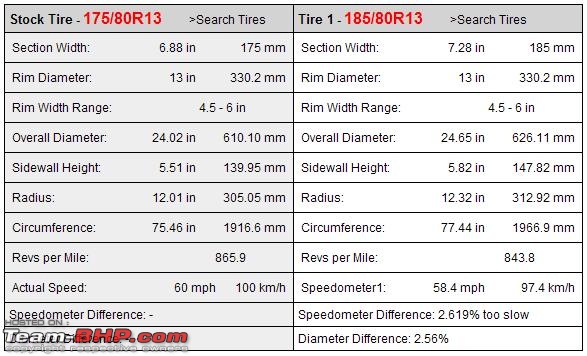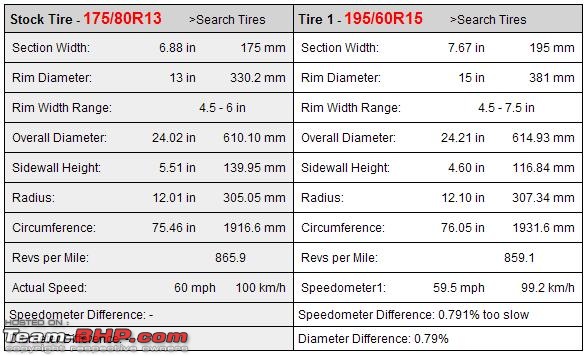Option 1 : Change from OE to Same width/Lower Profile Tyres.

Effects : Lowered car (Aprrox. 110mm ground clearance)
Option 2 : Change from OE to Wider Width/Lower Profile Tyres.

Effects : A “little” lowered car (Approx. 126mm ground clearance)
Option 3 : Change from OE to Wider Width/Higher Profile Tyres.

Effects : Approx. 157mm Ground Clearance + Slow Speedo Reading
Advantages : Better Suspension Feel, Good Ride Handling, Best Tyre Grip etc.,.
Option 4 : Change from OE to Wider Width/Higher Profile Tyres.

Effects : Negligible - Correct Upsize from 13" to 15"
(BMW wheel rims + Ford Fusion Tyres)
Any more wider tyres will foul with the wheel wells, when steering is in full lock positions.
All these trial and errors had been physically done by me, and verified. Getting BMW wheel rims, will sometimes may be more then the value of the car itself.
People who want to have any other wheel rims have to resort to mechanical modifications in this aspect. my mechanic suggests that he can alter the hub holes, such that the gypsy wheel rims can be fitted - which is yet to be verified, in real life.
Friends who have done any such alterations, please share your knowledge and technical details, for other users.
Contessa Classic: upgraded to stay in contest - By Tutu Dhawan (an old review about the contessa)
THE term ‘luxury car’ is indeed a luxurious term for India. For, till recently, India did not have a true luxury car to speak of. Then came the Contessa and Fiat 118 NE, for the upper crust who could not afford to be part of the stratospheric lot who drove ‘firangi’ cars.
The Contessa thus got the coveted title of India’s first practical ‘luxury’ car (we are not talking about the imports of the Sixties). Contessa, which became a Classic in 1986, had an Isuzu powerplant displacing 1,817 cubic centimetres and for the first time in India, a 5-speed gear-box, featuring overdrive. The car also had a number of firsts to its credit, provided as factory-fitted. This included an electronic ignition system and an electric fuel pump.
Other state-of-the-art features included an adjustable dashboard rheostat, which could never be read in the night anyway, wooden dashboard panels, a long body for all those who believed big is beautiful and for the heavy right foot drivers a long crushing area to keep him safe in case of a crash.
The car had a decent pick-up and performance and the engine was literally bullet-proof - people used to do 2 lakh kilometres plus between overhauls. This was until the assault from lighter and faster cars such as Maruti’s Esteem, Daewoo’s Cielo and later, a host of others.
Over the years, a number of upgradations were done to the standard Contessa. Side impact bars were added, upholstery was improved, there was an attempt to improve the quality of fit, finish and furnishings and even power steering was added, but the basic mechanicals remained the same.
It is still one of the last remaining cars in India to feature rear-wheel drive. Anyway, the car had a great powerplant but tightening emission norms meant that the old carburettor had to make way for fuel injection. So good old Hindustan Motors went shopping and put in their master-stroke - a Bosch multi-point fuel injection (MPFI) system.
As a result of this, power was boosted to 82 bhp from the existing 74 and torque went up marginally to 14.3 kg. This has made almost no difference to the performance but the car is much smoother now and power delivery is seamless and smooth.
On the exterior, some changes have been made. Prominent among these is a black coloured spoiler with an integral LED stop lamp which is common across the model range and all Contessas since 1996 now come with twin headlamps, thereby addressing a long standing criticism of weak and unfocussed headlamps.
New for the exterior this time round is a new metal beading which runs along the side, and the aforementioned spoiler. The Contessa also gets smart new wheel caps and trendy colours like Champagne Gold and Kielder Green.
What however is annoying is that the petrol tank cap once more has reverted to the earlier system of being operable only from inside the boot. If the boot is full of luggage, for example, on a long trip, then much of it would be needed to be shifted before the awkward lever can be turned to loosen the cap. The lever is also quite fiddly and can take some getting used to. Although the petrol tank capacity is a massive 65 litres, which means that you would not like to burn a hole in your pocket too often, this system of refuelling is still a very inconvenient one.
Among other grouses were paint overruns especially in the back and badly fitting tail-lamp clusters. The quality of rubber in the boot and on the doors was also not up to the mark, which essentially means it came off! The spoiler looked as if it was stuck on by Araldite and the rear stop lamp refused to work. This is a shame, because the rest of the car had a very nice paint job and surprisingly, the doors fitted well and panel gaps were not too large. What must however be emphatically mentioned here is that the quality of the Contessa definitely seems to be improving, and the next few years should see fewer problems.
The interiors were better than the exterior. Polyurethane moulded seats of a design not very different from the Opel Astra have taken the place of the older seats and decent headrests now come fitted as standard. There is a rear centre seat arm-rest now like other cars in this segment and rear seat-belts too are standard equipment.
One thing worth mentioning here is the slumberette. This means that the front passenger seat can be folded flat for the big boss to put his feet upon, much like an airline first- class seat.
The glove-box is lit by two lamps. All very posh. Even the boot compartment has a light - this light existed in the older cars too, but now it is brighter. The boot space as can be expected is cavernous, but the high loading sill means luggage has to be lifted over and put inside, which could mean a lot of exercise. Best left to your servant.
Coming back to the interiors, though spartan they have massively improved in quality with good quality carpets and floor mats, all as standard. What is gone however is the extra two vents for the rear seats in the air-conditioning system which meant that backbenchers could have kept their cool faster. But cooling in a Contessa as most owners would agree, has never been a problem. That massive Sanden SD-508 compressor combined to a big condenser and evaporator, gives one of the best cooling effects of any Indian car and the interiors can turn into a fridge within minutes. No complaints certainly on the air-conditioning of this car at least! But the dashboard is still set too low which makes it difficult to read the instruments, more so in the night.
The steering wheel however is a meaty four spoke affair, enabling an excellent grip. It is genuinely one of the best steering wheels we have come across in any Indian car. Amazingly enough, Contessas can now be ordered with electric windows and central locking, factory-fitted. Child-proof rear door locks are standard.
One irritating feature here however is that the engine control module (ECM) is located in the passenger footwell area and front passengers would inevitably end up stepping on it. The wires also terminate rather untidily at the ECM which leads us to conclude that some wire might work lose this way.
Power delivery of the Contessa engine is now better. While it was always quite a refined unit, it manages to become smoother and fuel consumption is also down a little. We got around 10 kilometres to the litre with the air-conditioning on and about 11 kilometres without. These are city running figures, so long distance runs would be better. Pickup has not changed significantly as the Contessa remains a heavy car.
The car’s inherent problem of low ground clearance continues to plague it, with thuds and gashing sounds coming every time the Contessa goes over a speedbreaker. Otherwise, the car appears to run well, in fact, it is one of the quietest cars to run around in.
Today, in a world full of fancy cars with fancier names, many people tend to question the logic of buying a car like the Contessa, and not without reason. It is a ponderous car to drive, provided you are driving yourself.
In fact, in places of paid parking, the guy in charge would ask you double the amount of parking fees without batting an eyelid because of the length of the car, but it is one of the best cars to be chauffeured around in.
The back seat is most comfortable, air-conditioning excellent and the car has an extremely soft and compliant suspension, even though at times it rolls like a cargo ship on choppy waters. This car is to be recommended if you are willing to pass over small problems and faults and have a chauffeur. Then truly, as the advertisement mentions, it’s a limousine to every other car.
Courtesy - Tutu Dhawan
 (2)
Thanks
(2)
Thanks
 (3)
Thanks
(3)
Thanks





 . Mercs might come in a close second.
. Mercs might come in a close second.



